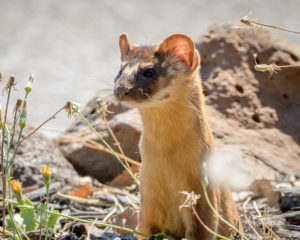Despite the fog, we still think of summer as beach season here in the Bay Area. And that’s one thing we have in common with the western snowy plover, a small bird that needs a lot of help to brave the crowds on San Francisco’s beaches.
If you like walking on the beach and maybe need incentive to get outthere on a regular basis, volunteering to watch, walk, and talk for thesnowy plover at Ocean Beach or Crissy Field may be just right for you. And you can start on July 5, 2010, when volunteers will be cleaning up the beaches to get ready for plover nesting season (get more info here).
The snowy plover is one of 36 endangered or threatened animal andplant species that call Golden Gate National Recreation Area home andyour volunteering can support the GGNRA’s efforts to protect the ploverin its San Francisco overwintering habitats from late July to mid-May.
Around the world, snowy plover populations are declining because wehumans like what they like — the beach. The plovers have an especiallydifficult time finding undisturbed beaches suitable for breeding andraising their young. In 1993 the U.S. Fish and Wildlife Service listedthe western snowy plover as a threatened species under the EndangeredSpecies Act. While snowy plovers overwinter on Ocean Beach and CrissyField, these beaches are too busy with human activity for the birds tobreed successfully here.
Snowy plover live on the exposed stretch of beach above the hightide line and below the sand dunes, and in urban areas, below the breakwalls and roadways. Audubon Society volunteer Dan Murphy monitors theflock on Ocean Beach. “I always see something I didn’t see before,” hesays. Plovers can fly but prefer to run along the beach in adistinctive “run-stop-run” pattern as they feed and watch for danger.They pick their food, especially flies, off the surface of the sand andseaweed. GGNRA Park Ranger George Dugerian likes to watch one of theplover’s more surprising feeding styles — running through a cloud ofbugs with its beak wide open.
For about two months in early summer, the birds migrate to quieterbeaches in Monterey and Santa Cruz counties as well as Point Reyes tonest and raise their young. Snowy plovers lay and tend their eggs onthe open beach. The buff-colored, gray-speckled eggs blend with thesand. Even on quiet beaches, successful reproduction is not certain.People and animals can unintentionally trample the exposed eggs. Or,sharp-eyed raptors and scavengers snatch the eggs and young when theparents are off feeding.
You can help the shorebirds through two volunteer programs:Shorebird Docents educate people at the beach about plovers and how toshare the beach with them. Docents with the Long-term MonitoringProgram collect data to monitor the species’ survival. Interns andvolunteers record tide, weather, bird counts, location, behavior, andsources of disturbances and threats. Monitoring is scheduled twice permonth on Wednesdays and Saturdays from July to May when small flocksoverwinter on Ocean Beach and at Crissy Field.
“Volunteers serve as ambassadors and provide maps, guides, and talkwith visitors about the snowy plover,” explains GGNRA Park RangerGeorge Durgerian. It’s a particularly good volunteer job for people whoalready come to the beach regularly, and working in pairs is a good wayto combine volunteering and socializing. “It’s a great way to gettogether with a friend,” he says.
GGNRA Wildlife Ecologist Bill Merkle, who coordinates the Long-termMonitoring Program, says the count at Ocean Beach is between 20 and 30individual snowy plovers each season. Over at Crissy Field, a fewplovers showed up at the beach in 2002 after the restoration of CrissyField and installation of the Wildlife Protection Area between 1998 and2000. While the counts at Crissy Field are very low, typically one tothree individual birds, their presence represents a remarkablere-introduction of a threatened species to a suitable habitat in themidst of a busy recreational area.
To volunteer for the Snowy Plover Outreach Program, contact GeorgeDurgerian at 415-335-8258 (cell) or email George_Durgerian@nps.gov andfor the Longterm Monitoring Program, contact Bill Merkle at415-331-2894 or Bill_Merkle@nps.gov.

.jpg)



